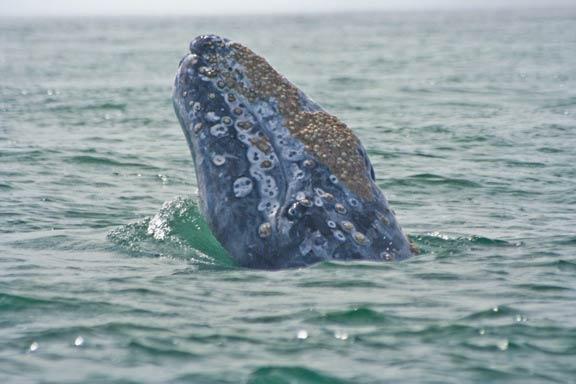Whale-Watching Season in Full Swing Off Calif. Coast


Some of the ocean's most graceful behemoths the gray whales are making their way on their migratory journey, a 10,000-mile-long round-trip from the Bering Sea off the coast of Alaska to the lagoons of Mexico's Baja California.
And they don't get to take any food breaks along the way.
The whales' epic trek means that whale watchers can grab their binoculars and head out to catch glimpses of the beasts' huge tail flukes and backsides as the animals breach the water to get a breath of air.
Gray whales a type of baleen whale that moves along the Pacific Coast of North America leave their chilly homes in the Arctic in late October for the warm lagoons of southern California, where the giants give birth to their calves.
They also leave behind an Arctic that is just beginning to ice over, meaning they can't feed on the tiny crustaceans called amphipods that dwell at the sea bottom there.
"The grey whales will spend their summer months, approximately June through October, up in the Arctic in the Bering and the Chukchi seas, and they're basically trying to get as fat as they can," said Staci Shaut, whale-watching coordinator at the Birch Aquarium at the Scripps Institution of Oceanography in La Jolla, Calif.
These large creatures, which weigh about 2,000 pounds (900 kilograms) as adults, put on up to 16 inches (40 centimeters) of blubber over the summer enough fat to keep them going for their long, food-free, trip south.
Get the world’s most fascinating discoveries delivered straight to your inbox.
Whale-watching
Gray whales are en route to Baja, passing along the coast of San Diego from late December through mid-February. Whale-watching excursions are offered in most areas along the Pacific Coast, including San Diego and Monterey Bay, during those times.
The Birch Aquarium offers a tour on a 100-foot (30-meter) boat that leaves from Senago Bay, moves through the harbor and out into the Pacific Ocean.
From the boat, whale watchers usually see one or two gray whales on these tours, though on a good day that total can get up to eight. The immensity of the whales is impressively apparent. "They're about half the length of our boat," Shaut told OurAmazingPlanet. "But even from a distance, you can see their backs ... as they rise up to take a breath."
"When they go down for their deeper dives, you'll see their fluke or tail and that's about 10 to 12 feet [3 to 4 m] across. That's always everybody's favorite moment when that tail rises up out of the water," Shaut said.
Saving the whale
While whale-watching can be a thrill, it's also important for conservation , Shaut said.
"What we try to stress for our tours [is that] these are amazing animals," Shaut said. "The oceans are getting busier and busier every single day with recreational and just transportation of vessels ... and I think that it's really important to bring awareness that these animals are out there."
The gray whale has been close to extinction twice during its existence on Earth, Shaut said. Both times occurred when whaling was allowed in the 1850s and between 1915 and1920, she said. During these near-extinction times, the gray whale population dropped from about 20,000 to as low as 500. The number is up again since whaling was banned and now hovers around 20,000 to 22,000.
Gray whales are important for their ecosystem. They are a common prey of Orcas (or killer whales), and because of the plumes they create when feeding on the bottom of the ocean, they put nutrients back into the water, which keep bottom-dwelling crustaceans happy.





